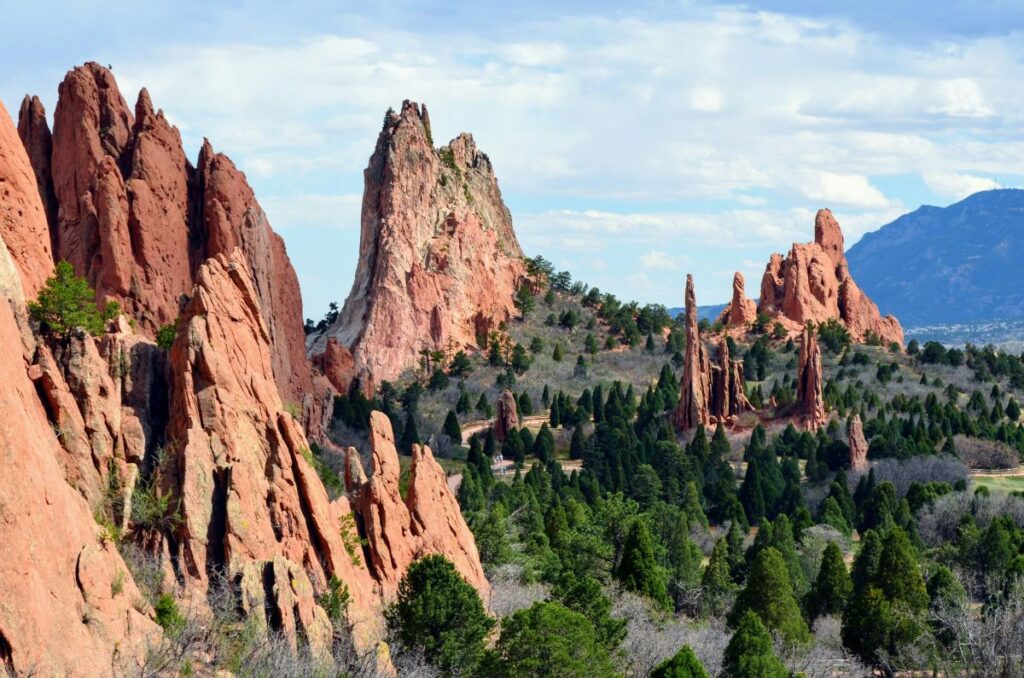Nestled at the base of Pikes Peak, Garden of the Gods stands as one of Colorado Springs’ most iconic and awe-inspiring destinations. This registered National Natural Landmark is renowned for its dramatic 300-foot sandstone rock formations, whose fiery red hues contrast beautifully against the snow-capped peaks and endless blue skies.
For locals and visitors alike, the park is more than just a scenic backdrop—it’s a living testament to the region’s geological, ecological, and cultural richness.
Experiencing Garden of the Gods Today
The story of Garden of the Gods begins over a billion years ago, when molten rock cooled to form the granite foundations of Pikes Peak and the Ancestral Rockies. Over hundreds of millions of years, the landscape underwent dramatic transformation: ancient seas advanced and retreated, sand dunes rose and fell, and dinosaurs once roamed the lush floodplains.
The park’s signature sandstone spires were originally vast sand dunes, later compressed and tilted skyward by powerful geological forces during the Laramide Orogeny about 65 million years ago. As softer rocks eroded away, the harder sandstone was left standing in the striking formations we see today—monoliths that have become a symbol of Colorado Springs itself.
A Sanctuary for Biodiversity and Discovery
Garden of the Gods is a unique ecological crossroads where the grasslands of the Great Plains meet the pinyon-juniper woodlands of the American Southwest and the mountain forests of the Rockies. This convergence creates a rich habitat for numerous plant and animal species, some of which are found nowhere else.
The park has even yielded new scientific discoveries, including previously unknown subspecies of insects and evidence of prehistoric life, such as dinosaur fossils and ancient petroglyphs. Whether you’re a birdwatcher, botanist, or casual hiker, the park’s trails offer endless opportunities to encounter Colorado’s natural wonders up close.
A Place Steeped in Human History
Long before Colorado Springs was founded, Garden of the Gods was revered by Native American nations as sacred ground. Archaeological evidence shows that people have visited the area for more than 3,000 years, drawn by its abundant wildlife and natural shelter. The Ute, Apache, Cheyenne, and other tribes all have stories and traditions tied to these red rocks.
In the 19th century, the land was purchased by Charles Elliott Perkins, who envisioned it as a public treasure. Honoring his wishes, his family deeded the property to the city in 1909, with the stipulation that it remain “forever free” and open to all. Today, the park’s legacy as a place of peace and inspiration continues, welcoming nearly two million visitors annually.
Experiencing Garden of the Gods Today

A visit to Garden of the Gods is an immersive experience. The Visitor & Nature Center offers interactive exhibits, educational programs, and the Geo-Trekker Theater, which takes guests on a journey through a billion years of geological history. Outdoor enthusiasts can explore over 15 miles of trails, ranging from easy walks to challenging hikes that wind among the towering rocks.
Activities like rock climbing, cycling, horseback riding, and photography are popular ways to engage with the landscape. The park is open year-round, and both admission and parking are free, making it accessible to all who wish to connect with Colorado’s wild beauty.
A Community Treasure and Source of Inspiration
Garden of the Gods is a source of local pride and a muse for artists, writers, and adventurers. Its ever-changing light and weather create a dynamic canvas that inspires creativity and reflection. The park’s preservation as a public space reflects the community’s commitment to safeguarding its natural and cultural heritage for future generations.